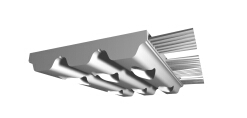Tooth profiles
ATP High performance profile

Market requirements for an increased performance, noise reduction and extension of the belts useful life led to the development of the ATP timing belt. The basic concept of the new ATP profile provides the division of the trapezoidal tooth into two individual and load bearing teeth. A remarkable advance in performance is achieved by the combination of fatigue resistant and low extension steel cord tension members and a custom-made polyurethane material.
Performance increase up to 60%, running noise reduced by up to 10 db(A) and an increased longevity by:
- tooth surface area increased by 70%
- uniform load/tension distribution
- improved power dispersion
- reduced polygon effect
- small construction width
- optimised tooth mesh
BAT Curved teeth

As a logical consequence of the demand for reducing running noise, a profile was developed which does without the conventional polygon effect. In addition to smooth running, the profile has, in comparison to the AT, a larger tooth face and is self-guiding in the preferred running direction.
Preferred use:
- special demands regarding smooth running properties and transmission precision
- tight assembly dimensions
- transport and transmission tasks
BATK Curved teeth with guiding track

The BATK has ensured from BAT. The timing belt is self-tracking in both running directions due to the integrated guiding track.
Preferred use:
- special demands regarding smooth running properties and transmission precision
- applications in the field of linear and power transmission technology
- tight assembly dimensions
AT High performance profile

Further development of the T profile resulted in the AT profile. This type of belt is characterised by the larger tooth shear strength resulting from the larger tooth volume and the stronger tension members.
Further advantages:
- favourable tooth mesh
- strengthened tension members for constant pitch and high breaking load
- improved performance up to 50 % as compared to the T profile
- precise transmission of movement in conjunction with synchronous pulleys with reduced or zero backlash
- reduction of meshing impacts or shocks
- favourable mass or build space relationship
SFAT Offset teeth

AT performance profile with toothed tracks with a belt designed as SFAT. These tooth tracks are offset by half a tooth pitch in relation to each other. In combination with the accompanying synchronous pulleys, the SFAT is self-guiding. No flanges are required.
Preferred use:
- running on synchronous pulleys without flanges
- where low noise is of the essence (reduced polygon effect)
ATK, TK Self-tracking belts

Self-tracking belts are a combined construction of synchronous belts and V-belts with straight running characteristics. The performance range is that of the standard T or AT profiles minus the non toothed belt width.
Preferred use:
- where large lateral forces apply
- running on synchronous pulleys without flanges
T Standard profile

The timing belt with a trapezoidal profile according to DIN 7721 is regarded as the classical standard timing belt.
Preferred use:
- for standard drive tasks
- transmission tasks with double-sided belts
- for high bending stress
- load case "with contraflexure"
Imperial Profile

Inch pitches according to DIN/ISO 5296 are available in following dimensions:
M = 2,032 mm
XL = 5,08 mm
L = 9,525 mm
H = 12,7 mm
XH = 22,225 mm
Preferred use:
- applications in imperial units
K Profile

Serrated metric pitch profile.
Preferred use:
- fine mechanical technology requiring small dimensions
F Flat belts

Preferred use:
- high-speed drives (CONTI® SYNCHROFLEX polyurethane timing belt)
- drives without synchronous transmission
- friction drives (open length and endless)
ATN Profile

The ATN timing belt is especially designed for the application in the transport technology. The flight fastening system in the belt tooth permits fast fitting and replacement of the flights individually manufactured for the conveying application concerned.
ATNK Profile

The ATNK is self-guiding due to the integrated guide key. For this reason, flanges on the pulleys are no longer necessary. The location of the guide key depends on the width of the timing belt.
HTD Profile

The high capacity profile HTD (high torque drive) with a round tooth for a perfect meshing behaviour and optimised force - and load distribution (profile according to the design ISO/F DIS 13050). The HTD tooth additionally offers a high jumping resistance.
Preferred use:
- linear transmissions
- lifter
- positioning drives
N10 Profile

The profile N10 (Nup pitch length 10 mm) has rotation symmetrical nups with involutes for an optimum meshing behaviour and a god force and load distribution. The optimised meshing behaviour of the nups results in noise reduction. The drive has no polygons and is self-guiding in both directions.
Preferred use:
- transport drives
- application without flanges
- low noise drives
STD Profile

The high capacity profile STD (super torque drive) with an involute meshing for a perfect meshing behaviour and optimised force - and load distribution (profile according to the design ISO/F DIS 13050). In addition the optimised meshing behaviour of the STD tooth results in noise reduction in the drive.
Preferred use:
- linear transmissions
- positioning drives
- low noise drives